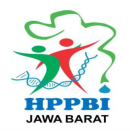Keanekaragaman Jenis Capung (Ordo Odonata) Pada Berbagai Tipe Habitat Di Kecamatan Leuwiliang Kabupaten Bogor
Abstract
Keywords
Full Text:
PDFReferences
Abdul, N. H., Rawi, C. S. M., Ahmad, A. H., & Al-Shami, S. A. (2017). Effect of Environmrntal Disturbances on Odonata Assemblages along a Tropical Polluted River. Ekologia Bratislava, 36(4), 388–402. https://doi.org/10.1515/eko-2017-0030
Albab, A. U., Leksono, A. S., & Yanuwiadi, B. (2019). Land Use Analysis with Odonata Diversity and Composition using the ArcGIS in Malang and Batu , East Java. J-Pal, 10(2), 73–83. https://doi.org/10.21776/ub.jpal.2019.010.02.01
Ansori, I. (2011). Keanekaragaman Odonata (Dragonflies) Di Beberapa Persawahan Berdasarkan Sex Rasio Odonata Dewasa dan Panjang Tubuh (Instar) Nimfa Odonata. Seminar Nasional XI Pendidikan Biologi FKIP UNS, 1(1), 471–477.
Borror, D. J., A, T. C., & Johnson, N. F. (1996). Pengenalan Pelajaran Serangga, Edisi ke-enam. Terjemahan oleh Partosoedjono. UGM Press.
BPS Kabupaten Bogor. (2020). Kecamatan Dalam Angka Dalam Angka Kecamatan. BPS Kabupaten Bogor.
Bruno, C. G. C., Gonçalves, R. C., Dos Santos, A., Facure, K. G., Corbi, J. J., & Jacobucci, G. B. (2022). The relationship between sediment metal concentration and Odonata (Insecta) larvae assemblage structure in Cerrado streams. Limnetica, 41(1), 27–41. https://doi.org/10.23818/limn.41.03
Hermawan, A. S., & Fitriana, N. (2015). Jenis dan fluktuasi capung pada Taman Kota Bumi Serpong Damai, Tangerang Selatan, Banten. Pros Sem Nas Masy Biodiv Indon, 1, 1795–1801. https://doi.org/10.13057/psnmbi/m010808
Ilhamdi, M. L., Idrus, A. Al, Santoso, D., & Hadiprayitno, G. (2020). Short communication: Community structure and diversity of Odonata in Suranadi Natural Park, West Lombok Indonesia. Biodiversitas, 21(2), 718–723. https://doi.org/10.13057/biodiv/d210238
Jacob, S., Thomas, A. P., & Manju, E. K. (2017). Odonata ( Dragonflies and Damselflies ) as Bio Indicators of Water Quality. International Journal of Innovative Research in Science, Engineering and Technology, 19464–19474. https://doi.org/10.15680/IJIRSET.2017.0609144
Janra, M. N. (2018). Inventory of dragonflies and damselflies (Odonata) in Andalas University’s Limau Manis Campus Compex, Padang: Usiang Photographical Approach. Jurnal Natural, 18(2), 85–88. https://doi.org/10.24815/jn.v18i2.11133
Jara, F. G. (2014). Trophic ontogenetic shifts of the dragonfly Rhionaeschna variegata: The role of larvae as predators and prey in Andean wetland communities. Annales de Limnologie, 50(2), 173–184. https://doi.org/10.1051/limn/2014010
Kalkman, V. J., Clausnitzer, V., Dijkstra, K. D. B., Orr, A. G., Paulson, D. R., & Van Tol, J. (2008). Global diversity of dragonflies (Odonata) in freshwater. Hydrobiologia, 595(1), 351–363. https://doi.org/10.1007/s10750-007-9029-x
Krebs, C. J. (1998). Ecological Methodology, 2nd Ed. Harper & Row Pub.
Lino, J., Koneri, R., & Butarbutar, R. R. (2019). Keanekaragaman Capung (Odonata) Di Tepi Sungai Kali Desa Kali Kabupaten Minahasa Sulawesi Utara. Jurnal MIPA, 8(2), 59. https://doi.org/10.35799/jmuo.8.2.2019.23767
Mafuwe, K., & Moyo, S. (2020). Dragonfly (Odonata) community structure in the Eastern Highlands Biodiversity Hotspot of Zimbabwe: potential threats of land use changes on freshwater invertebrates. International Journal of Odonatology, 23(4), 291–304. https://doi.org/10.1080/13887890.2020.1768156
Magurran, A. E. (2004). Ecological Diversity and Its Measuring. Blackwell Science Ltd.
Makaure, J., Caston, M., & Sithole, M. (2015). Assessment of upper thermal tolerances of naiads of two odonate families : Coenagrionidae and Libellulidae in Lake Kariba , Zimbabwe. Elixir Applied Zoology, 80(80), 31201–31206. https://www.elixirpublishers.com/articles/1427372581_80 (2015) 31201-31206.pdf
Martín, R., & Maynou, X. (2016). Dragonflies (Insecta: Odonata) as indicators of habitat quality in Mediterranean streams and rivers in the province of Barcelona (Catalonia, Iberian Peninsula). International Journal of Odonatology, 19(3), 107–124. https://doi.org/10.1080/13887890.2016.1172991
Pamungkas, D. W., & Ridwan, M. (2015). Keragaman jenis capung dan capung jarum (Odonata) di beberapa sumber air di Magetan, Jawa Timur. 1(September), 1295–1301. https://doi.org/10.13057/psnmbi/m010606
Rahadi, W. S., Feriwibisono, B., Nugrahani, M. P., Putri, B., & Makitan, T. (2013). Naga terbang Wendit: keanekaragaman capung perairan Wendit, Malang, Jawa Timur. Indonesia Dragonfly Society.
Rahayuningsih, M., Oqtafaiana, R., & Priyono, B. (2012). Keanekaragaman jenis kupu-kupu Superfamili Papilionoidae di Dukih Banyuwindu Desa Limbangan Kecamatan Limbangan Kabupaten Kendal. Jurnal MIPA, 35(1), 11–20. http://journal.unnes.ac.id/nju/index.php/JM
Rahmawati, I., Sulistiyowati, T. I., & Rohim, A. N. (2018). Bagian tumbuhan yang digunakan capung (Odonata) untuk hinggap di Air Terjun Irenggolo Kediri. Jurnal Biologi Dan Pembelajarannya, 5(2), 38–40. https://ojs.unpkediri.ac.id/index.php/biologi/issue/view/119
Remsburg, A. (2011). Relative influence of prior life stages and habitat variables on dragonfly (Odonata: Gomphidae) densities among lake sites. Diversity, 3(2), 200–216. https://doi.org/10.3390/d3020200
Rizal, S., & Hadi, M. (2015). Inventarisasi jenis capung (Odonata) pada areal persawahan di Desa Pundenarum Kecamatan Karangawen Kabupaten Demak. Bioma : Berkala Ilmiah Biologi, 17(1), 16–20. https://doi.org/10.14710/bioma.17.1.16-20
Schröder, N. M., Rippel, C. G., Walantus, L. H., Zapata, P. D., & Pessacq, P. (2020). Odonata assemblages as indicators of stream condition – a test from northern Argentina. North-Western Journal of Zoology, 16(2), 117–124. https://biozoojournals.ro/nwjz/content/v16n2/nwjz_e201101_Schroder.pdf
Siregar, A. Z. (2016). Keanekaragaman dan Konservasi Status Capung di Kampus Hijau Universitas Sumatera Utara, Medan-Indonesia (Diversity and Status Conservation of Odonata in Green Campus University of North Sumatera, Medan-Indonesia). Jurnal Pertanian Tropik, 3(1), 25–30. https://jurnal.usu.ac.id/index.php/tropik/article/view/13172
Suartini, N. M., & Sudarti, N. W. (2019). Spesies capung (Ordo Odonata) pada pertanaman padi di beberapa sawah Sekitar Denpasar, Bali. Simbiosis, VIII(1), 23–28. http://ojs.unud.ac.id/index.php/simbiosis
Suaskara, ida B. M., & Joni, M. (2020). Keanekaragaman jenis capung dan pemanfaatan nimfanya sebagai nilai tambah pendapatan di Bendungan Latu Abiansemal. Simbiosis, VIII(1), 28–33. http://ojs.unud.ac.id/index.php/simbiosis
Teristiandi, N., & Riyanto, R. (2021). The Abundance of Odonata Insect in Lebak Swamp, Bukit Baru, Palembang, Indonesia. Jurnal Biologi Tropis, 21(1), 255–261. https://doi.org/10.29303/jbt.v21i1.2456
Veras, D. S., Lustosa, G. S., Moura, L. P., Ferreira, M. F. R., & Juen, L. (2020). Differences in land use modify odonata assemblages in the cerrado-caatinga ecotone. Acta Limnologica Brasiliensia, 32, 1–11. https://doi.org/10.1590/S2179-975X7119
Villalobos-Jiménez, G., Dunn, A. M., & Hassall, C. (2016). Dragonflies and damselflies (Odonata) in urban ecosystems: A review. European Journal of Entomology, 113(1), 217–232. https://doi.org/10.14411/eje.2016.027
Virgiawan, C., Hindun, I., & Sukarsono. (2015). Studi keanekaragaman capung (Odonata) sebagai bioindikator kualitas air Sungai Brantas Batu-Malang dan sumber belajar biologi. Jurnal Pendidikan Biologi Indonesia, 1(2), 188–196. https://ejournal.umm.ac.id/index.php/jpbi/article/view/3330
Wahizatul-Afzan, A., Julia, J., & Amirrudin, A. (2006). Diversity and distribution of dragonflies (Insecta: Odonata) in Sekayu Recreational Forest, Terengganu. Journal of Sustainability Science and Management, 1(2), 97–106. https://jssm.umt.edu.my/files/2012/07/97-106.pdf
Wakhid, Rauf, A., Krisanti, M., Sumertajaya, I. M., & Maryana, N. (2020). Aquatic insect assemblages in four urban lakes of Bogor, West Java, Indonesia. Biodiversitas, 21(7), 3047–3056. https://doi.org/10.13057/biodiv/d210723
Wakhid, Rauf, A., Krisanti, M., Sumertajaya, I. M., & Maryana, N. (2021). Aquatic insect communities in headwater streams of ciliwung river watershed, West Java, Indonesia. Biodiversitas, 22(1), 30–41. https://doi.org/10.13057/biodiv/d220105
Wakhid, W., Koneri, R., Tallei, T., & Maabuat, P. V. (2014). Kelimpahan Populasi Capung Jarum (Zygoptera) di Kawasan Taman Nasional Bogani Nani Wartabone, Sulawesi Utara (Population Abundance of Damselfly (Zygoptera) in Bogani Nani Wartabone National Park, North Sulawesi). Jurnal Bios Logos, 2(1). https://doi.org/10.35799/jbl.4.2.2014.5234
Wijayanto, A. G., Nafisah, N. A., Laily, Z., & Zaman, M. N. (2016). Inventarisasi Capung (Insecta: Odonata) dan Variasi Habitatnya di Resort Tegal Bunder Dan Teluk Terima Taman Nasional Bali. Seminar Nasional Pendidikan Dan Saintek, 1, 427–434.
Zaman, M. N., Fuadi, B. F., Purwanto, P. B., Syafii, I., Yusuf, M., Hidayat, M. R., Hardhaka, T., Adi, A., Laily, Z., Ikram, A. M., Rifai, A. S., & Rouf, M. S. A. (2018). Kenaekaragaman capung (Odonata) di Pulau Nusakambangan Bagian Barat. SEMINAR NASIONAL PENDIDIKAN BIOLOGI DAN SAINTEK III, 142–248.
Refbacks
- There are currently no refbacks.
Copyright (c) 2022 Quagga: Jurnal Pendidikan dan Biologi

This work is licensed under a Creative Commons Attribution-NonCommercial-ShareAlike 4.0 International License.
QUAGGA : Jurnal Pendidikan dan Biologi
ISSN 1907-3089 (print), ISSN 2651-5869 (online)
Organized by Biological Education Study Program, Faculty of Teachers Training and Education, Universitas Kuningan, Indonesia.
Website : https://journal.uniku.ac.id/index.php/quagga/index
Email : [email protected]
Address : Jalan Cut Nyak Dhien No.36A Kuningan, Jawa Barat, Indonesia.

Ciptaan disebarluaskan di bawah Lisensi Creative Commons Atribusi-BerbagiSerupa 4.0 Internasional.






